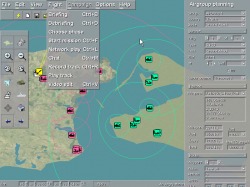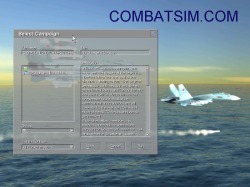| The Russians Are Coming: Flanker 2.0 in Review | ||||
|
The canned missions come in 4 types: Pilot, Squadron, General and Track or recorded missions. The difference between the first three types reflects how the missions were made and what impact the individual pilot has on the overall success of the mission. The Pilot mission's outcome depends upon the individual pilot to achieve his/her specific target goals. The Squadron Leader mission's outcome depends upon the leader's ability to achieve the goals through the squadron's success. The General mission's success is dependent upon the overall success of his/her resources compared to the enemy. Note that it is optional if the General even flies in the mission itself, since he/she may choose to play as an observer.
 The Mission Editor itself in F2 is a very powerful tool. Its strengths are in its ease of use, a single interface for both solo and multiplayer, and full control of the mission objects and their placement by the designer. Its weaknesses are that it bogs down when 50+ object densities are reached, poor cursor control if you use a Voodoo card (soon to be patched), and multiplayer host/guest user model. What is powerful about the Mission Editor is that it is packed with lots of goodies. It is designed around three mechanisms to run it: pull down menus, icons, and function key commands. The GUI is built upon a 3D graphics approach. What that gives you is a very attractive theatre map with colorful objects and menus. Here is where you not only build your missions and campaigns, but also the mission briefs, flight package loadouts, video editing of mission track files, meteorological settings, survivability, and system failure programming. What mission track files do is allow you to replay your mission and see what you did right or wrong, as well as a means to prove competition claims. Where track files have an advantage over a simple ACMI recorder is that you can take over and refly a mission or even edit the viewing for training purposes. These are excellent features for virtual squadron purposes! When in multiplayer mode, you can use a chat window to talk with other players BEFORE the mission begins as a way to synch up flights and objectives. |
On the other hand, the mission editor requires each online player to add their own flight, routes, and objectives. This inability to have guests or clients simply add their pre-built mission data to the host or master's makes the pre-flight work load a chore, and if the master has a network disconnection then all is lost. It is a possibility that the ability to have clients add their missions to the master's may be an upgrade feature in a follow on to Flanker2.0 because this requires a rewrite of the mission editor itself. Again, note that it is here in the mission editor that one can enable the player's custom camo skins by choosing the "european1" color scheme. This is a great feature for virtual squadrons because these camos can be seen by others online if they also have your camo loaded on their system.
 Campaign Structure, Pilot Records Campaigns in F2 are not the dynamic force acting upon force as was the current trend in contemporary deep play simulations. This is both a pro and a con. The pro is that F2 does not suffer the processor overhead loading it takes to manage a real time virtual war. Along with this comes game stability and fewer bugs for the developer and the customer to suffer. The cons are that you lose the immersion factor and the lasting effects of losses and damage. Missing also is the concept of pilot career and statistics. For the solo player, this is a big hole in the armor indeed. Campaigns are implemented in a conditional branching structure. What this means is that the outcome of each mission, or phase is contingent on a set of pre-assigned conditions. Depending upon whether or not certain conditions are met will determine if the player can advance to the next phase in the campaign. Depending upon how much planning is built into the success or failure conditions, there are many different branches in how the campaign can be played out. In theory, you could design an infinite number of outcomes, but it's totally within the control of the campaign designer as to the complexity and the locus of possibilities. Go to Page Five
|
|||
|
Copyright © 1997 - 2000 COMBATSIM.COM, INC. All Rights Reserved. Last Updated November 29th, 1999 |
||||
